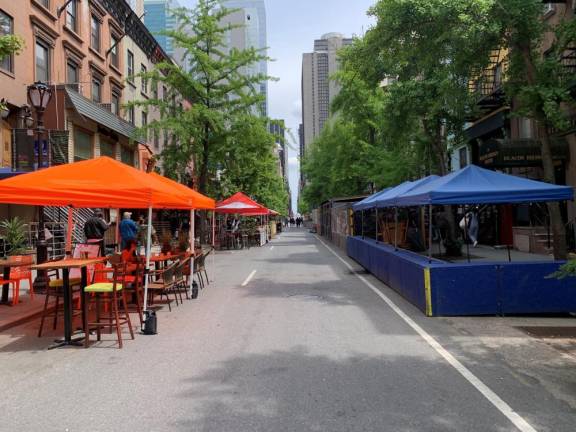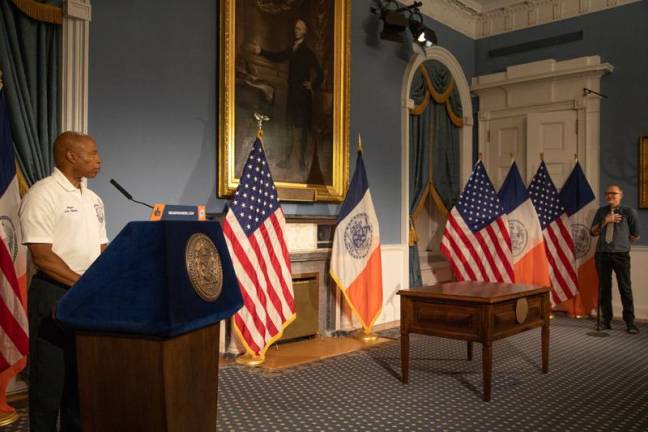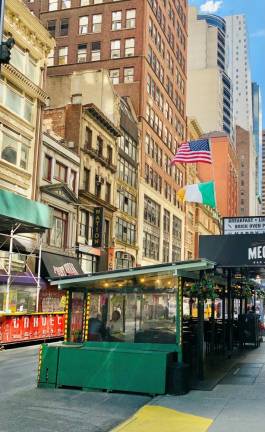“Outdoor Dining is Here To Stay” Says Adams as He Signs Shed Bill into Law
Mayor Eric Adams, had pushed Dining Out NYC to allow dining sheds to be a permanent part of the city. The bill he signed on Aug. 16 which which was passed by the City Council two weeks ago, allows sheds to seasonal allowed to stay up only from April to November, while sidewalk cafes are now allowed to stay up all year long. .



NEW YORK (AP)–Outdoor dining was a part of the pandemic that many people actually liked–made possible by streetside dining sheds that popped up around the City and allowed many restaurants to stay in business when they couldn`t have diners inside.
Now with Eric Adams signing on Aug 16 of a bill passed by the City Council two weeks ago, the dining sheds will be allowed, permanently, albeit seasonal from April to November while sidewalk cafes can operate year round. The law is now expanded to all five boroughs, and proponents said it makes NYC the home of the largest outdoor dining program in the country.
“Outdoor dining is here to stay, New York,” said Mayor Adams.“New Yorkers were hungry for a cleaner, safer, healthier outdoor dining program, and we are delivering for them with Dining Out NYC. The temporary open restaurants program saved 100,000 jobs and kept our neighborhoods vibrant — but too many abandoned sheds attracted rats and detracted from the beauty of our city.
Adams said the bill that was hammered out after a year of negotiations City Council had comprises. “Dining Out NYC locks in the best parts of outdoor dining and gets rid of the worst—for restaurants, for communities, and for diners alike. We’re going to bring New Yorkers the largest, best outdoor dining program in the country.”
Some community activists wanted the sheds gone for good and raised concerns like increased noise and congestion, loss of street space, and argued that some are dilapidated, abandoned structures that are eyesores. that attracted rodents and worse. Restaurant owners said the sheds were a Godsend that helped them navigate the darkest days of the pandemic and boosted their business as they still struggled in post pandemic world.
Some sheds were simple–wooden structures with basic cutouts for light, a few tables, the occasional plastic sheeting to keep out rain and snow. Other restaurants got more into it–choosing decor to match the restaurant`s interiors and adding heaters, plants and plush seating.
Just like the mix of feelings about the sheds themselves, there has been a wide range of reactions to the new system.The processes for permitting, fees and licensing–as well as design requirements, still need to be decided.
Many restaurants would have preferred to see street dining allowed permanently, but are glad to see it will still be possible for most of the year, said Andrew Rigie, executive director of the New York City Hospitality Alliance, a trade group for the city`s restaurants and nightlife venues.
“Of all the doom and gloom in the pandemic, one of the bright spots was outdoor dining,” he said. “By utilizing a little area in the roadway, you’re able to create a whole new experience for people that are going to dine out, people that are walking around.``
“I think it creates, when done properly, a much more livable, much more vibrant streetscape than simply keeping or using it just for parking,” Rigie said.
Leif Arntzen, a member of the Coalition United for Equitable Urban Policy, could not disagree more. He and his group adamantly opposed the expansion of sidewalk dining into the roadbeds. They said the city should have done an impact study on neighborhoods before taking any moves toward making it permanent.
“For residents, it`s less curb space, less sidewalk space, less roadbed space, less space to get up and down the block, less quiet, less emergency access, it`s just less,” he said. “It’s more for one industry, less for everybody else.”
Mathias Van Leyden, owner of LouLou bistro in Chelsea neighborhood, is sympathetic to those who are put off by makeshift structures, some of which have been abandoned around the city, and painted over with graffiti or otherwise vandalized.
But not his, Van Leyden said, pointing out that he invested a significant amount into an outdoor shed that has windows, is decorated and comes portable.
“Some people are not doing it right, they`re the ones who are making us look bad, “ he said.
Even with the requirement to remove the sheds for the winter months, he`s happy to see the city agreeing to keep streetside dining.
“We’re happy that New York`s moving in the direction,`` he said. It`s “a bit more European, where we have people sitting outside, makes the street a little more lively.``
Valarie Marrs isn`t sold. She was sitting in a restaurant`s street shed in the East Village recently and called the pop-up structures “terrible.”
“They litter up the street so badly, they take away from the aesthetics of the streets,” she said. “They’re trash magnets, they’re just awful.”
Sitting next to her, Daniel Laitman disagreed. “I like them,” he said. “If it`s too hot inside from the ovens, it`s a cool space. And if it`s not that hot, then it’s like a breeze coming in from everywhere.”
Maulin Mehta, New York director for the Regional Plan Association, an organization that advocates around infrastructure and other issues and which supports alternative uses of city streets, considered the City Council legislation for a permanent program to be a step forward.
“I think there’s a way to get this right. And now that we actually have this framework in place, the legislation, we can start thinking about the future program,” Mehta said.
He said, “It gives us a chance to sort of move beyond the emergency crisis and really think about the future for our streets and sidewalks.”
Copyright 2023 The Associated Press. All rights reserved.